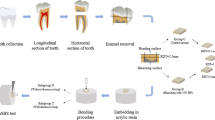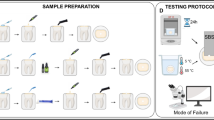Abstract
The purpose of this study was to evaluate the tensile bond strength (TBS) to peroxide-exposed dentin. Furthermore, the effect of ascorbic acid (AA) on the bond strength of peroxide-exposed dentin was investigated. Extracted bovine dentin was exposed to 10% carbamide peroxide, 30% hydrogen peroxide, or distilled water for 30 min, then treated with 10% AA (0, 30, 90, and 180 min), and conditioned with 10% citric acid/3% ferric chloride. The polymethyl-methacrylate (PMMA) rod was bonded to the treated bovine dentin with 4-META/MMA-TBB resin. A minidumbbell-shaped bonded specimen was prepared from these bonded assemblies and the TBS was tested. The fractured surfaces were also observed with a scanning electron microscope. Exposure to peroxide before bonding significantly reduced bond strength. The application of AA to the peroxide-exposed dentin increased bond strength. On the other hand, an adverse effect of AA was found in distilled water-affected dentin. Extended resin fibers were partially seen in the peroxide-exposed dentin. In conclusion, peroxide reduced the bond strength, and the stronger the oxidation, the weaker the obtained bond. Antioxidation with AA recovered the bond strength, and this effect increased the longer the AA was applied.


Similar content being viewed by others
References
Arao T (1997) Effect of miniaturized dumbbell-shaped specimen to identify bonding of bovine dentin. J Jpn Dent Mater 16:175–181
Barghi N, Godwin JM (1994) Reducing the adverse effect of bleaching on composite-enamel bond. J Esthet Dent 6:157–161
Belli S, Zhang Y, Pereira PNR, Ozer F, Pashler DH (2001) Regional bond strengths of adhesive resins to pulp-chamber dentin. J Endod 27:527–532
De Munck J, Van Meerbeek B, Yoshida Y, Inoue S, Suzuki K, Lambrechts P (2004) Four-year water degradation of resin-modified glass-ionomer adhesive bonded to dentin. Eur J Oral Sci 112:73–83
Gutteridge JMC (1991) Hydroxyl radical formation from the auto-reduction of a ferric citrate complex. Free Radic Biol Med 11:401–406
Gutteridge JMC (1994) Biological origin of free radicals, and mechanisms of antioxidant protection. Chem Biol Interact 91:133–140
Halliwell B, Gutteridge JMC (1996) Chemistry of free radicals and related ‘reactive species’. In: Halliwell B, Gutteridge JMC (eds) Free radicals in biology and medicine, 3rd edn. Oxford University Press, London, pp 53–67
Hanazaki Y, Watanabe A, Nakabayashi N (1999) The effect of water-soluble noncollagenous proteins on resin bonding to dentin. J Jpn Dent Mater 18:375–379
Inoue S, Murata Y, Sano H, Kashiwada T (2002) Effect of NaOCl treatment on bond strength between indirect resin core-buildup and dentin. Dent Mater J 21:343–354
Ishizuka T, Kataoka H, Yoshioka T, Suda H, Iwasaki N, Takahashi H, Nishimura F (2001) Effect of NaClO treatment on bonding to root canal dentin using a new evaluation method. Dent Mater J 20:24–33
Iwasaki Y, Toida T, Nakabayashi N (2004) Improved wet bonding of methyl methacrylate-tri-n-butylborane resin to dentin etched with ten percent phosphoric acid in the presence of ferric ions. J Biomed Mater Res 68A:566–572
Kameyama A, Kawada E, Takizawa M, Oda Y, Hirai Y (2000) Influence of different acid conditioners on the tensile bond strength of 4-META/MMA-TBB resin to Er:YAG laser-irradiated bovine dentin. J Adhes Dent 2:297–304
Kameyama A, Ihara S, Amagai T, Miake Y, Kawada E, Oda Y, Yanagisawa T, Hirai Y (2003) Adhesion of 4-META/MMA-TBB resin to heated dentin: effects of pre-treatments with FeCl3 and/or HEMA. Dent Mater J 22:1–9
Kataoka H, Yoshioka T, Suda H, Imai Y (1999) Effect of sodium hypochlorite on adhesion of 4-META/MMA-TBB resin to dentin. Jpn J Conserv Dent 42:241–247
Kaya AD, Turkun M (2003) Reversal of dentin bonding to bleached teeth. Oper Dent 28:825–829
Lai SCN, Mak YF, Cheung GSP, Osorio R, Toledano M, Carbalho RM, Tay FR, Pashley DH (2001) Reversal of compromised bonding to oxidized etched dentin. J Dent Res 80:1919–1924
Lai SCN, Tay FR, Cheung GSP, Mak YF, Carbalho RM, Wei SHY, Toledano M, Osorio R, Pashley DH (2002) Reversal of compromised bonding in bleached enamel. J Dent Res 81:477–481
Magne P, Belser U (2002) Bonded porcelain restorations in the anterior dentition: a biomimetic approach, 1st edn. Quintessence, Chicago, USA, pp 102–104
Okamoto Y, Takahata K, Saeki K (1998) Studies on the behavior of partially oxidized tributylborane as a radical initiator for methyl methacrylate (MMA) polymerization. Chem Lett 27:1247–1248
Perdigao J, Lopes M, Geraldeli S, Lopes GC, Garcia-Godoy F (2000) Effect of a sodium hypochlorite gel on dentin bonding. Dent Mater 16:311–323
Rose RC, Bode AM (1993) Biology of free radical scavengers: an evaluation of ascorbate. FASEB J 7:1135–1142
Soeno K, Taira Y, Matsumura H, Atsuta M, Suzuki S (2004) Adhesion of 4-META/MMA-TBB resin to collagen-depleted dentin: effect of conditioner with ascorbic acid/ferric chloride. Dent Mater J 23:100–105
Spyrides GM, Perdigao J, Pagami C, Araujo MAM, Spyrides SMM (2000) Effect of whitening agents on dentin bonding. J Esthet Dent 12:264–270
Stokes AN, Hood JA, Dhariwal D, Patel K (1992) Effect of peroxide bleaches on resin-enamel bonds. Quintessence Int 23:769–771
Takarada K, Nikaido T, Kojima M, Nakabayashi N (1990) Novel method to observe the interface between adhesive resin and dentin by staining Fe3+ with tannic acid. J Jpn Dent Mater 9:363–367
Titley KC, Torneck CD, Ruse ND (1992) The effect of carbamide–peroxide gel on the shear bond strength of a microfill resin to bovine enamel. J Dent Res 71:20–24
Torneck CD, Titley KC, Smith DC, Adibfar A (1990) Adhesion of light-cured composite resin to bleached and unbleached bovine dentin. Endod Dent Traumatol 6:97–103
Wakabayashi Y, Kondou Y, Suzuki K, Yatani H, Yamashita A (1994) Effect of dissolution of collagen on adhesion to dentin. Int J Prosthodont 7:302–306
Van Landuyt KL, De Munck J, Snauwaert J, Coutinho E, Poitevin A, Yoshida Y, Inoue S, Peumans M, Suzuki K, Lambrechts P, Van Meerbeek B (2005) Monomer-solvent phase separation in one step self-etch adhesives. J Dent Res 84:183–188
Vargas MA, Cobb DS, Armstrong SR (1997) Resin–dentin shear bond strength and interfacial ultrastructure with and without a hybrid layer. Oper Dent 22:159–166
Yazaki K, Kawada E, Oda Y (2003) An evaluation of the penetration of peroxide from tooth-whitener. Biomed Res 24:325–330
Yiu CKY, Garcia-Godoy F, Tay FR, Pashley DH, Imazato S, King NM, Lai SCN (2002) A nanoleakage perspective on bonding to oxidized dentin. J Dent Res 81:628–632
Acknowledgements
We would like to thank Mr. Katsumi Tadokoro (Oral Health Science Center, Tokyo Dental College) for technical advice on SEM. We would also like to thank Sun Medical and ATD Japan for providing materials. This study was supported in part by Grants-in-Aid for Scientific Research from the Ministry of Education, Culture, Sports, Science and Technology, Japan, no. 14571862 (to E. K.) and no. 14571863 (to K. Y.).
Author information
Authors and Affiliations
Corresponding author
Additional information
K. Yazaki was formerly affiliated with Department of Pharmacology, Tokyo Dental College, 1-2-2, Masago, Mihama-ku, Chiba 261-8502, Japan. He is now in private practice.
Rights and permissions
About this article
Cite this article
Nomoto, S., Kameyama, A., Nakazawa, T. et al. Influence of ascorbic acid on bonding of peroxide-affected dentin and 4-META/MMA-TBB resin. Clin Oral Invest 10, 325–330 (2006). https://doi.org/10.1007/s00784-006-0071-2
Received:
Accepted:
Published:
Issue Date:
DOI: https://doi.org/10.1007/s00784-006-0071-2




